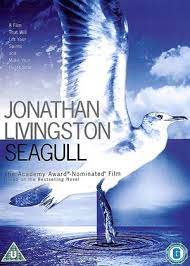Articles/Essays – Volume 07, No. 4
Jonathan Livingston Seagull: An Ornithologist’s Rod McKuen | Richard Bach, Jonathan Livingston Seagull
Listen-up bird-lovers, Hindus, Eddy Rickenbacker, Father Schillebeechx, and Unitarians everywhere: Jonathan Livingston Seagull has arrived! Somewhat sooner and with greater flurry than many of us would have wished, perhaps, but, then, that’s his style, and style is, ultimately, what J. L. Seagull is all about.
If you haven’t read the book (a feat no less impressive than never having seen an “un-cola” billboard) nor been “enlightened” (sic) by a friend, then let us say that it is about a bird . . . and from there it is all down hill, at speeds in excess of 214 MPH—something of a breakthrough, actually. But rather than go into any further details concerning this hard-cover pamphlet’s plot—it takes longer to summarize than to read—we may simply note that not having read it puts one in a better position to critique the book than having invested the thirty minutes (outside) that it takes to carefully study it. Having read it one must admit to having done so, whereby one’s judgement and integrity become immediately suspect.
It’s really not too surprising that Seagull should come along just now. The Marxist theory of literature and history should have clued us that, what with the “counter-culture” having predictably tired of the Eastern philosophies and turned to Christianity, something of a synthesis was in the offing. First Ginsberg chanting his mantras on Johnny Carson, then Superstar, and finally Harrison’s “My Sweet Lord” with a “krishna” chorus thrown in for “relevancy.” How marvelous!
And where does Seagull fit in? A few steps behind where the establishment always is, like a gaggle of greedy geese (or seagulls, if you prefer, although it doesn’t scan as well) gobbling the crumbs left behind by the “freaks”—crumbs turned, somehow, respectable through the mediation of time and practice. Hence the paradox: culture, counter-culture, synthesis—and we are all the same again, with Seagull delivering the coup de grace this time.
This whole business about virgin birth and divine parenthood has always been a bit sloppy anyway—neither good for business nor conducive to the life of a conservative “swinger”—so, when something comes along (with pretty pictures, no less) to offer a socially acceptable alternative, it is little wonder that “Middle America” should snatch it up. As it turns out, however, the alternative is even more incredible than the initial premise. One is merely asked to believe that a seagull who looks like Charlton Heston, sounds like Kahlil Gibran, and has the moves of Parnelli Jones, appeared to one Richard Bach and unravelled for him life’s knot. In the process, J. L. Seagull (Jesus Christ) is revealed to be mere mortal, the Great Gull (God) is inferred to be a pleasant myth by which to encourage the flock (you and me) until such time as they, we, or whoever attain a higher sphere of existence where everyone talks like the result of having unsuccessfully mated Dale Carnegie with Ralph Williams (“. . . of ‘Ralph William’s Ford/ right on the corner of . . .”).
All of this I am willing to let go by the boards in the interest of free speech, poetic license, or whatever. Indeed, I should have bitten my tongue and silently thought, “that’s alright, Bach, you’ll get yours,” were it not for two blatant travesties which are in need of being set right.
Firstly, Jonathan Livingston Seagull, which is assumed by its editors to be “a story,” is the most simple-minded bit of tractarian nonsense since Robinson Crusoe, which has the advantage of being fun. With all the subtilties of a wet mop, Bach has established himself as the newest oracle of our time. Thus following in the McKuen tradition which assumes that if one gushes enough one may be mistaken for a fountain at which humankind may go to drink, Bach has proven the assumption sadly true. However, like Henry VIII’s involvement with the Anglican Church, one may wonder if it is any more than an inept rationale on the part of Bach for the abandonment of his domestic responsibilities. In either case such a criticism is probably too cynical and too simple. Bach may well believe in what he is doing, which makes it all the more a pity that he does it so poorly.
Secondly, and perhaps more importantly, Bach assumes—nay, insists—that seagulls are lazy creatures in dire need of reform. Now, I don’t know about “Middle America,” but I have always liked seagulls just the way they are. They eat crickets. Where would Brigham and the Saints have been had the seagulls been converted earlier to clicking-off power-dives for fun and profit (no pun intended). No, I like gulls as they are, and if they don’t sell as many cars that way, well, I can stand the loss.
Jonathan Livingston Seagull: make a point to miss it, unless an illiterate Rod McKuen (intentional redundancy) in feathers (not too difficult to imagine, really) is your idea of a good time.


 Back to full Issue
Back to full Issue

